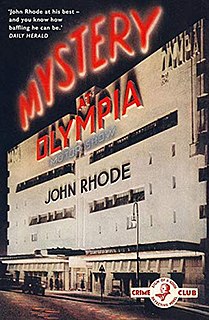
Mystery at Olympia is a 1935 detective novel by John Rhode, the pen name of the British writer Cecil Street. It is the twenty second in his long-running series of novels featuring Lancelot Priestley, an armchair detective who was able to solve mysteries without visiting the scene of the crime. It was published in the United States under the alternative title Murder at the Motor Show.

Death at Breakfast is a 1936 detective novel by John Rhode, the pen name of the British writer Cecil Street. It is the twenty third in his long-running series of novels featuring Lancelot Priestley, a Golden Age armchair detective. It received a negative review from Cecil Day-Lewis, writing as Nicholas Blake in The Spectator noting "Some attempt is made to establish the character of the victim, but the remaining dramatis personae are stuffed men".

Death in the Hopfields is a 1937 detective novel by John Rhode, the pen name of the British writer Cecil Street. It is the twenty fifth in his long-running series of novels featuring Lancelot Priestley, a Golden Age armchair detective. It was published in America by Dodd Mead under the alternative title The Harvest Murder.

Invisible Weapons is a 1938 detective novel by John Rhode, the pen name of the British writer Cecil Street. It is the twenty eighth in his long-running series of novels featuring Lancelot Priestley, a Golden Age armchair detective. A locked room mystery, the title revolves around the fact that two murders are committed by apparently invisible methods.
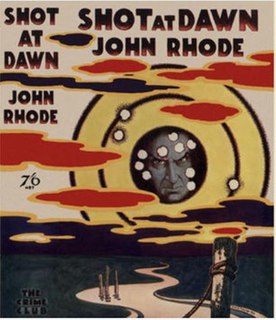
Shot at Dawn is a 1934 detective novel by John Rhode, the pen name of the British writer Cecil Street. It is the nineteenth in his long-running series of novels featuring Lancelot Priestley, a Golden Age armchair detective. It was one of the best received novels in the series. In a review in the Sunday Times Dorothy L. Sayers wrote "Mr. John Rhode is one of those kind, thoughtful writers who patiently explain all the technical points of the narrative in words that a child could understand." Ralph Partridge in the New Statesman observed "Shot At Dawn is developed in that incalculable way which keeps one’s attention at the stretch, until the very last page—I actually got a thrill out of the verdict of the jury! The Crime Club has selected the book, and I certainly could not better their selection from the detective novels that have come my way in the last few months."

Poison for One is a 1934 detective novel by John Rhode, the pen name of the British writer Cecil Street. It is the eighteenth in his long-running series of novels featuring Lancelot Priestley, a Golden Age armchair detective. It combines elements of the locked room mystery and country house mystery. Reviewing the book in the Sunday Times leading crime writer Dorothy L. Sayers considered it "as usual, sound, pleasantly written, and entertaining" although she complained the book "was rather spoilt for me by the jacket, which deliberately gives away one-half of the solution."
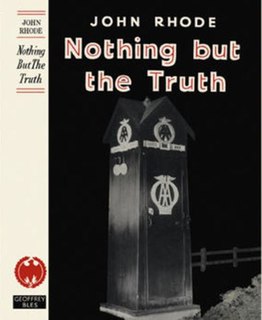
Nothing But the Truth is a 1947 detective novel by John Rhode, the pen name of the British writer Cecil Street. It is the forty forth in his long-running series of novels featuring Lancelot Priestley, a Golden Age armchair detective.

Death in Harley Street is a 1946 detective novel by John Rhode, the pen name of the British writer Cecil Street. It is the forty third in his long-running series of novels featuring Lancelot Priestley, a Golden Age armchair detective. Several sources consider it to be the author's masterpiece.
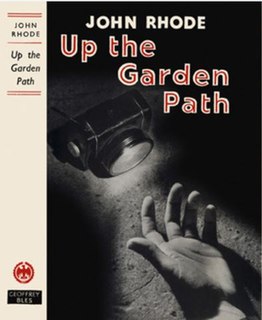
Up the Garden Path is a 1949 detective novel by John Rhode, the pen name of the British writer Cecil Street. It is the forty ninth in his long-running series of novels featuring Lancelot Priestley, a Golden Age armchair detective. It was published in America by Dodd Mead under the alternative title The Fatal Garden. Reviewing the novel in The Observer, Maurice Richardson concluded "Mr. Rhode has lost very little of his grip."

The Two Graphs is a 1950 detective novel by John Rhode, the pen name of the British writer Cecil Street. It is the fiftieth in his long-running series of novels featuring Lancelot Priestley, a Golden Age armchair detective. It was published in America by Dodd Mead under the alternative title Double Identities. Writing in The Observer Maurice Richardson noted a "slight slackening of tension towards the finish but an excellent specimen of Rhode’s later period."
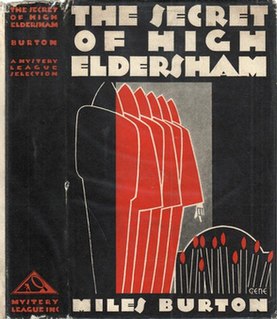
The Secret of High Eldersham is a 1930 detective novel by Miles Burton, the pen name of the British writer Cecil Street. It was the first novel in a lengthy series featuring the detective Desmond Merrion. Street was one of the most prolific authors of the Golden Age of Detective Fiction and had already enjoyed success with his Doctor Priestley series, written under the name of John Rhode. In 1931 it was published in the United States by the Mystery League under the altered title The Mystery of High Eldersham. Originally published in Britain by the Collins Crime Club, it was reissued in 2016 by British Library Publishing as part of a series of crime novels the Golden Age.

The Claverton Mystery is a 1933 detective novel by John Rhode, the pen name of the British writer Cecil Street. It is the fifteenth in his long-running series of novels featuring Lancelot Priestley, a Golden Age armchair detective. It was published in the United States by Dodd Mead with the altered title The Claverton Affair. The tone of the book has been described as much darker than the author's other novels.
Dr. Priestley's Quest is a 1926 detective novel by John Rhode, the pen name of the British writer Cecil Street. It was the second appearance of the armchair detective Lancelot Priestley, who featured in a long-running series of novels during the Golden Age of Detective Fiction. It has been described as the first major detective novel by the author. In its relationship between Priestley and his secretary and future son-in-law Harold Merefield is shown the influence of Conan Doyle's Sherlock Holmes and Watson. Similarly, Inspector Hanslet of Scotland Yard fulfils a similar role to that of Lestrade.

The Ellerby Case is a 1927 detective novel by John Rhode, the pen name of the British writer Cecil Street. It marked the third appearance of the armchair detective Lancelot Priestley, who featured in a long-running series of novels during the Golden Age of Detective Fiction. The novel's success led to a contract with Dodd Mead to release it and subsequent novels in the United States, in what proved to be a lucrative arrangement for the author.
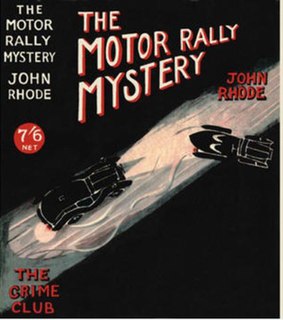
The Motor Rally Mystery is a 1933 detective novel by John Rhode, the pen name of the British writer Cecil Street. It is the fourteenth in his long-running series of novels featuring Lancelot Priestley, a Golden Age armchair detective. It was published in the United States by Dodd Mead under the alternative title Dr. Priestley Lays a Trap. It takes place against the backdrop of the real life RAC Motor Rally, which concluded at Torquay.

The House on Tollard Ridge is a 1929 detective novel by John Rhode, the pen name of the British writer Cecil Street. It marked the sixth appearance of the armchair detective Lancelot Priestley, who featured in a long-running series of novels during the Golden Age of Detective Fiction. The plot was partly inspired by Rudyard Kipling's short story Wireless, which Rhode mentions in the novel.

Dead on the Track is a 1943 detective novel by John Rhode, the pen name of the British writer Cecil Street. It is the thirty seventh in his long-running series of novels featuring Lancelot Priestley, a Golden Age armchair detective. Like a number of mystery novels of the era, it has a railway setting. In theme and plot it is very similar to the author's earlier 1931 work Tragedy on the Line. It is the first entry in the series since Hendon's First Case (1935) in which Priestley's old associate Hanslet is the lead investigator. The other recurring police officer in the series Inspector Jimmy Waghorn is now working with military intelligence.

Peril at Cranbury Hall is a 1930 detective novel by John Rhode, the pen name of the British writer Cecil Street. It marked the eight appearances of the armchair detective Lancelot Priestley, who featured in a long-running series of novels during the Golden Age of Detective Fiction. The use of the cipher inspired a similar one used in Dorothy L. Sayers's Have His Carcase

The Venner Crime is a 1933 detective novel by John Rhode, the pen name of the British writer Cecil Street. It is the sixteenth in his long-running series of novels featuring Lancelot Priestley, a Golden Age armchair detective. In Britain it was published by Odhams Press, the only one of his works be done so, while in the United States it was handled by his usual publisher Dodd Mead. It has been described as a sort of sequel to his previous book The Claverton Mystery. Writing in the New York Times Isaac Anderson considered "This is not one of the best of the Dr. Priestley yarns, but it is plenty good enough to pass an idle evening."

Dead Men at the Folly is a 1932 detective novel by John Rhode, the pen name of the British writer Cecil Street. It is the thirteenth in his long-running series of novels featuring Lancelot Priestley, a Golden Age armchair detective. It was published in the United States by Dodd Mead.



















